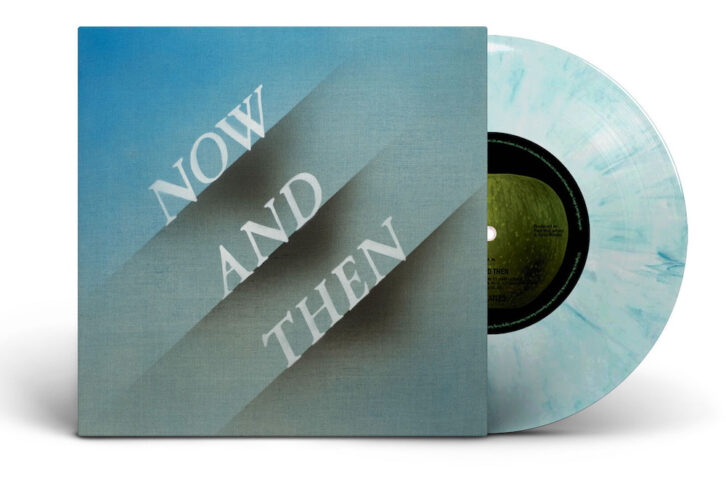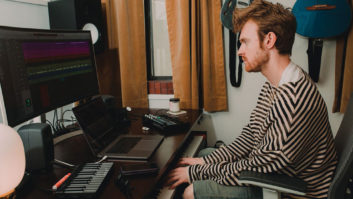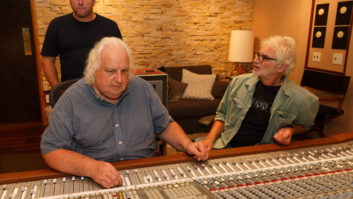
New York, NY (October 26, 2023)—With the cat out of the bag, we can finally spill the beans about the “new” Beatles track, “Now and Then,” which was announced today. The new track—due to be released next Thursday, November 2—has been literally decades in the making, completing a 30-year quest to finish a song nearly 50 years old by using sonic elements drawn from across a nearly 60-year span. The result isn’t a musical Frankenstein’s Monster, but instead, a canny earworm rescued from oblivion and built into a complete and proper song.
The new tune, played for the press at a top-secret listening event at Dolby’s NYC headquarters in late September, is vintage Lennon, sporting a simple, melancholy verse melody on piano that is instantly unforgettable, eventually leading into a thick, chewy chorus that may not match the verse for sheer magnificence, but which fits comfortably into the Beatles’ oeuvre all the same.
The Beatles Release Final Song ‘Now And Then’ and Production Documentary
The track originally came from a cassette recording of Lennon at the piano sometime in the late 1970s; Yoko Ono eventually gave the three-song demo tape to Paul McCartney, George Harrison, and Ringo Starr in 1994 when they were working on the mid-1990s Anthology project. The remaining Beatles built out “Free As A Bird” and “Real Love” with Jeff Lynne of ELO as their producer, and released the pair of tracks as singles for the first two Anthology albums. Both were solid songs, but each was blemished by the watery, spectral Lennon vocals that were extracted from the cassette as best could be managed at the time, given the audio technology of the era. Given that there were three Anthology collections, “Now and Then” was originally intended to be the single for the final album, but it was not to be.
The three remaining Beatles recorded some new parts for “Now and Then,” going so far as to create a rough mix at the time, but ultimately opted not to complete the song. The reasons given were myriad, from the bandmembers running out of time to record, to Harrison reportedly not being fond of the song to begin with, to the original cassette’s terrible recording quality, which featured prominent room noise, a hum throughout and a TV set blasting in the background—all of which made for a song that was a gem but still unusable all the same.
Fast-forward 30 years, however, and audio technology has progressed significantly. In an era of denoising plug-ins, digital stem-separation services and other ways to revitalize challenging audio, McCartney spearheaded an effort to finally bring “Now and Then” into the Now. In truth, he’d never forgotten about the song, bringing it up in interviews occasionally in the intervening decades to say that he wanted to take another go at it, despite the added complication of George Harrison having passed in 2001.

When filmmaker Peter Jackson put together the docuseries The Beatles: Get Back in 2021, his WingNut Films company developed a proprietary stem-separation technology, MAL, to demix the raw documentary footage’s mono audio into usable, multi-stem recordings, allowing hitherto unheard voices and sounds buried in the raw tapes to be clear and audible in the film’s final mix. With that project completed, Jackson and his audio team, led by Emile de la Ray, were enlisted to apply MAL to the garbled cassette audio of Lennon playing “Now and Then.” The team sent back three stems—the piano, everything else in the room, and Lennon’s vocal, which had been extracted as a strong, solid voice with nary a trace of the ghostly wavering so prevalent in “Free Like A Bird” and “Real Love.”
In 2022, McCartney and Starr began working on completing the song with the help of Giles Martin, the go-to immersive mixer for Beatles projects in recent years, not to mention son of Beatles’ producer George Martin. There was plenty of material to work with—in addition to the newly retrieved stems, there were various acoustic and electric guitar parts by Harrison available from the 1990s session. Building on those foundational elements, Starr played a new drum part while McCartney augmented things further with bass, guitar, piano, electric harpsichord and shaker, as well as a Harrison-esque slide guitar solo.
Heightening the song’s inherent drama, an urgent string arrangement for the track, written by McCartney, Martin and Ben Foster, was recorded at Capitol Studios in Los Angeles—it was, in fact, the very last session before the entire Capitol Tower, including the studios, was shut down for two years of extensive renovations and structural repairs. Needing to imbue the song with the Beatles’ trademark harmonies, McCartney and Starr provided new BVs. Those were also augmented with backing vocals taken from the original recordings of “Here, There And Everywhere,” “Eleanor Rigby” and “Because,” though the pieces were not used in a way that draws attention to their having been lifted from elsewhere.
Despite the track being built from elements recorded on a variety of formats over the course of nearly 60 years, “Now and Then” gels together surprisingly well—enough so that the credits for the tune are likely more complicated than the song itself. Ultimately the producers are McCartney and Martin, with Lynne credited for additional production. Meanwhile, Geoff Emerick, Steve Orchard, Greg McAllister, Jon Jacobs, Steve Genewick, Bruce Sugar and Keith Smith all share engineering credits. The track was mixed by Spike Stent and mastered by Miles Showell, and the recording facilities of record are Hog Hill Studio, Capitol Studios and Roccabella West.
With the track now complete, it will debut November 2 in 7-inch, 12-inch and cassette formats as a double A-side release, backed by the band’s debut song, “Love Me Do,” neatly bookending the Beatles’ musical output. Atmos mixes of the tracks, mixed by Martin, will debut on streaming that day as well. The song will also appear as part of newly expanded re-releases of the Beatles’ 1962-1966 (‘The Red Album’) and 1967-1970 (‘The Blue Album’) collections, which will debut a week later on November 10.
As for the use of WingNut Films’ MAL technology on other recordings in the Beatles’ archives, it was noted at the press event that there are no current plans to re-extract Lennon’s vocals and remix “Free As A Bird” and “Real Love,” but it was also cryptically offered that the massive Anthology project—which begat a TV series, eight-volume VHS and 5-volume DVD sets, a book and three multi-CD sets—will reappear, making revised tracks derived from the Lennon cassette seemingly inevitable.
For now, however, there’s “Now and Then,” a track that thematically and musically sees the band’s journey end on a solid coda, rightfully earning the tagline that it’s being marketed with: “The Last Beatles Song.”







